Toyota 'brothers' victory that was forged in defeat: 2021 Le Mans 24 Hours report
The first Le Mans 24 Hours victory of the Hypercar era went to Toyota, but 2021 is just the start, with the race offering a sense of the competition to come
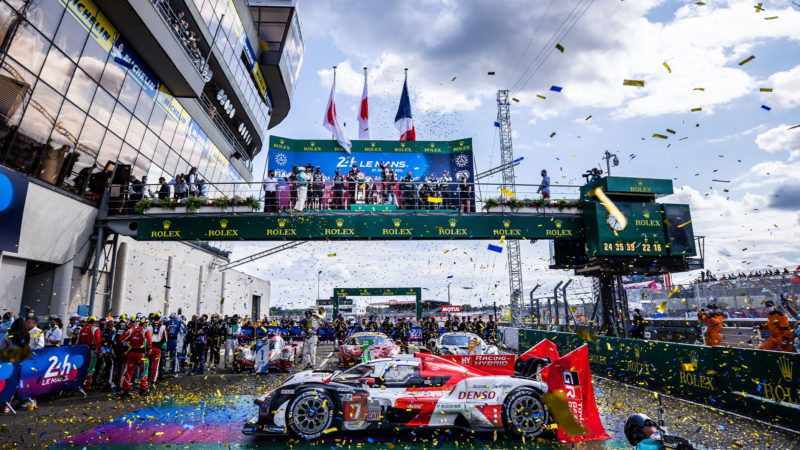
Germain Hazard/DPPI
The main event for the 89th running of Le Mans was the Hypercar class debut, and the works Toyota GR 010s were always going to be the favourites. Despite Hypercar being a Balance of Performance class – each car has technically the same power, aero performance and weight – over a lap of the Circuit de la Sarthe, even a marginal advantage can rapidly become decisive, and Toyota’s years of experience and not inconsiderable resource meant they were best placed to find that edge.
Come the Hyperpole qualifying session it became apparent the GR010 indeed had ferocious pace when needed. Le Mans pole maestro Kamui Kobayashi fired off a blistering 3min 23.9sec lap in the No7, with his teammate a few tenths behind, surprising the Hypercar competition and locking out the front row.
Luca Ciancetti, engineering head at Podium Advanced Technologies, which builds Scuderia Cameron Glickenhaus’s SCG 007, remarked that while he expected high-24s from the Japanese outfit, the mid-23sec pace potential was unexpected. Toyota clearly had performance to spare. However, there were no changes to the BoP between qualifying and the race and the consensus was that race pace would be more closely matched. This would prove to be the case, with most racing laps in Hypercar at or around the ACO’s stated target of 3min 30sec.
Another star of qualifying was Hub Auto Racing with the No74 Porsche 911, which pulled off something of a coup in GTE Pro. The team only ran with its car for the first time during the pre-race test, yet managed to put it on class pole, ahead of the factory efforts. Sadly for the team, it would ultimately retire from the race with mechanical failure, the cumulative result of a host of on-track incidents.
The only adjustment to the BoP over race week was prior to Hyperpole; the Ferrari Pro entries were stung after blitzing the rest of the field by ¾ of a second during Wednesday’s practice/qualifying session. A boost reduction ensued, dropping engine power by around 8bhp coupled with a 1-litre fuel capacity cut. Despite the adjustment, come race time, the restriction seemed to do little harm to the pace of the Italian cars.
It always rains at Le Mans
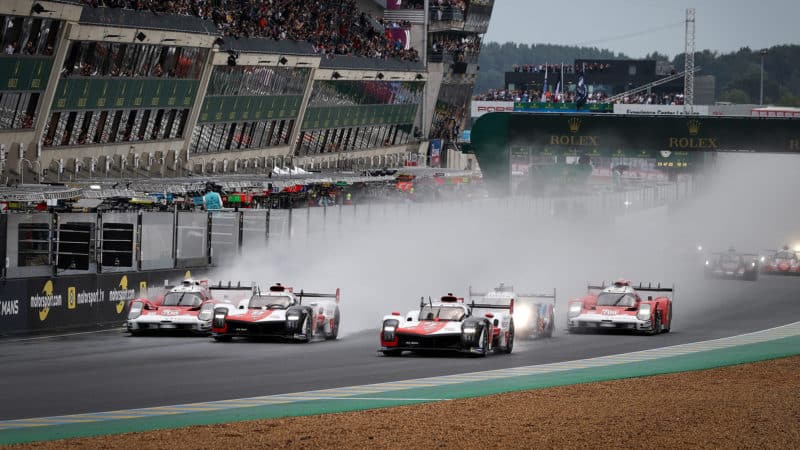
The race gets underway after two safety car laps
Toyota
The start could best be described as chaos; heavy rain fell while the cars were forming on the grid and though it eased considerably as they rolled off, the first two laps were completed under the safety car. With drivers struggling to keep heat in their tyres it was inevitable some would run out of luck at the green flag.
As the pack charged into the Dunlop curves on lap three, finally up to racing speed, the No7 Toyota of Mike Conway pulled clear; Buemi in the No8 was less fortunate as Olivier Pla, in the No708 Glickenhaus, locked up and punted him into a spin. Buemi recovered but had to pull off the track to ‘reboot’ the car, losing a substantial chunk of time; the first of a number of setbacks that would blight what is normally the luckier side of the Toyota garage. Pla’s punishment for his part in the fracas was a ten second penalty at the first pitstop round.
The drama continued to unfold down the field. Maxime Martin, opening driving for the Hub Auto Porsche, clashed with the No48 LMP2 of Patrick Pilet pitching both far down the order. Further woes in the Hypercar category then unfolded as Nicolas Lapierre spun the grandfathered Alpine LMP1 (now classed as a Hypercar) coming out of Indianapolis. As a result, if only for a brief while, Glickenhaus filled out second and third places, before a hard charging Antonio Felix Da Costa in the Jota Oreca P2, running on intermediate rather than full wets, managed to overtake both on lap eight.
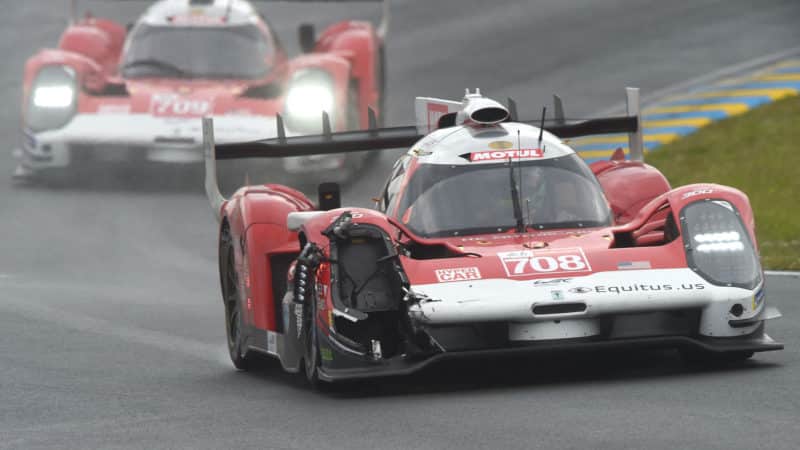
Olivier Pla was given a 10sec penalty and lost time for pitstop repairs after his first lap collision with No8 Toyota
Jean-Francois Monier/AFP via Getty Images
With the sun breaking through, the track began to dry but remained greasy; rewarding those brave enough to push on yet swiftly punishing the overconfident. Mollina in the No52 GTE Ferrari took advantage of the conditions and managed to seize the class lead from the debuting C8 Corvettes, which had been the big winners of the opening lap chaos. However, the chasing factory Porsches were nowhere to be seen, having opted to stay on full wets, as opposed to inters; Neel Jani noted that team did not expect the safety car to stay out so long and thought the track would stay wetter.
As the initial round of pitstops played out, the order after the first hour was Toyota 1-2, followed by Alpine and the two Glickenhaus cars, though all split by a variety of LMP2s. Finally, after 80 minutes of racing, Buemi managed to get back past the Jota P2 machine and set off in pursuit of its sister car, closing up and even taking the lead by lap 30, as the No7 pitted. However; shortly after the #8 almost came another cropper as Buemi tangled with the No39 Graff Oreca piloted by Arnold Robin.
With further rain holding off, the race settled into something of a rhythm, as cars throughout the field tried to make up ground lost in the opening laps. In GTE Pro, the battle for the lead became a family affair, with the two AF Corse Ferraris gapping the field, with the best of the rest, by now Earl Bamber in the No79 Weathertech Porsche, some 12 seconds back. Somewhat surprisingly, the Italian team let its two drivers get up close and personal for several laps.
Not to be outdone by their Pro compatriots, the battle in GTE Am was no less intense, the Aston Martins of TF Racing and AMR taking the top two spots in the opening stages, pedalled by Felipe Fraga and Nicki Thiim respectively. Nicklas Nielsen in the No83 AF Corse Ferrari was in hot pursuit, while TF Sport’s other driver Ross Gunn kept him within range and clear of a quartet of chasing Ferraris.
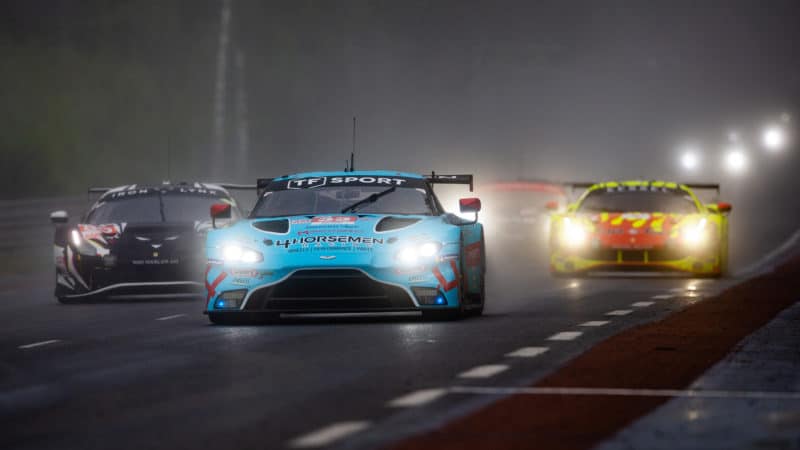
Intense battle in GTE AM class led here by No33 Aston Martin
Joao Filipe/DPPI
The rain would return after two and a half hours, starting as a light drizzle before increasing in intensity but never reaching a level where tyre changes were required, and the track was clear by the three-hour mark. Though the instigator of the lap one incident with Toyota, following a nose change, the No708 Glickenhaus – which had appeared the stronger of the pair all week – made steady progress back through the field, and after 45 laps had recovered to sixth place, gradually reeling in the No29 Racing Team Netherlands and No26 G-Drive P2s.
Despite the frantic action of the opening hours, the complete starting field remained on track. This changed when the No98 GTE Am of Aston Martin Racing triggered a safety car at the three-and-a-half-hour point. Driver Marco Gomes took a very heavy hit coming into Indianapolis, displacing no less than six layers of tyres and the Armco behind. In a testament to circuit and car safety standards, Gomes, though clearly winded, was able to walk away, with the car an instant retirement.
Then the rain came, and all hell broke loose.
With the entire field on slicks, what had been predicted as rain, intensity 1-2 (light), turned out to be somewhat heavier. LMP2 seemed to bear the brunt of the ensuing chaos, compounded it seems by some having communications problems with the pits, leaving drivers unaware of approaching wet conditions. Listeners to the radio feed were treated to a flurry of expletives from Racing Team Netherlands owner Felix van Eerd as he beached in the gravel, enquiring in a suitably Dutch fashion why no one had warned him rain was falling.
In short order, Sophia Floersch in the No1 Richard Mille was collected by youngster Franco Colapinto in the No26 G-Drive on the entry to Porsche Curves. Floersch appeared blameless, the victim of Colpinto spinning out unassisted. Unfortunately, while trying to get her stricken machine into gear, she was speared by Tom Cloet in the No74. With the slick conditions, it seemed Cloet had no hope of avoiding the German, though Floersch had a different opinion when interviewed on her return to the garage. Sadly for Floersch and the RM team, the second impact triggered the medical light in the car, meaning she had no option but to retire and head straight to the medical centre.
The LMP2 class was truly decimated. As the rain faded and darkness began to fall, the No28 Jota was stuck in the garage. Anthony Davidson had suffered an uncharacteristic slip-up, resulting in a trip across the gravel, some of which got stuck between the floor and engine, puncturing the oil filter. Similarly incarcerated was the No23 of Paul Di Resta, who had been leading the class before he was clobbered by fellow United Autosports driver Manuel Maldonado skipping across the gravel at Dunlop. This incident merely compounded problems for a team that had been one of the class favourites heading into the race, Zak Brown’s outfit having struggled to find any meaningful pace in the opening hours.
https://twitter.com/24heuresdumans/status/1429162344421134336?s=21
Even once the rain was gone, the incidents didn’t abate. The 2019 WEC GTE Am champion Egidio Perfeti in the No56 Project 1 Porsche appeared to suffer a mechanical failure into the first chicane, pirouetting into the tire barrier, promptly followed by GTE Am leader Felipe Fraga, the No33 TF Sport Aston, triggering a safety car and retirement for Project 1.
The two Corvettes met with mixed fortunes as night closed in, Nicky Catsburg was leading in the No63 as the seventh hour of running rolled around, but the No64 finally succumbed to damage acquired, somewhat bizarrely, from the No51 when leaving the grid. The diffuser was damaged, and it finally gave up, necessitating an extend stay in the pits. The performance of both the Corvettes and Porsches seemed to swing considerably with the conditions, and in the cooler hours, the American muscle could not quite match the Ferraris, a situation that would endure throughout the race.
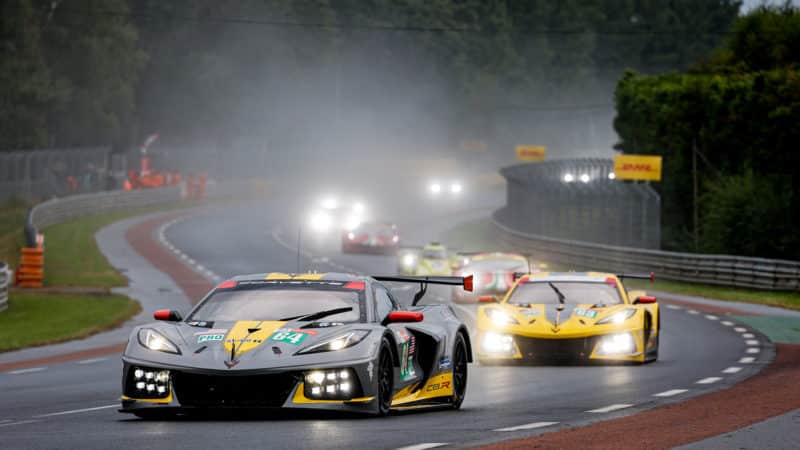
Corvettes started at the front of GTE Pro class, but had mixed fortunes as the race wore on
Francois Flamand/DPPI
As midnight rolled around, drivers and teams settled into the more conservative rhythm that all know is needed to survive the early hours. The leaders in each class remained relatively unchanged, though in Hypercar Glickenhaus continued its climb up the leaderboard, with the No708 swapping third and fourth places with Alpine through the pitstop cycles. However, it was through the cool night hours that the No7 Toyota crew began to grow what would become an unassailable lead, its drivers putting in a series of rapid stints.
In LMP2, WRT held on to the top two slots, with the third place No28 Jota was locked in battle with the No65 of Panis Racing. Meanwhile, the GT battles continued with Ferrari’s leading both Pro and AM, shadowed by Corvette racing and the TF Sport Aston respectively. However, what had been a two-car assault by AF Corse in Pro faltered with the No52 of Molina hitting suspension trouble at the 14-hour point, dropping it eight laps off the lead battle, promoting the No92 Porsche with Kevin Estre to third in class, albeit nearly a lap down.
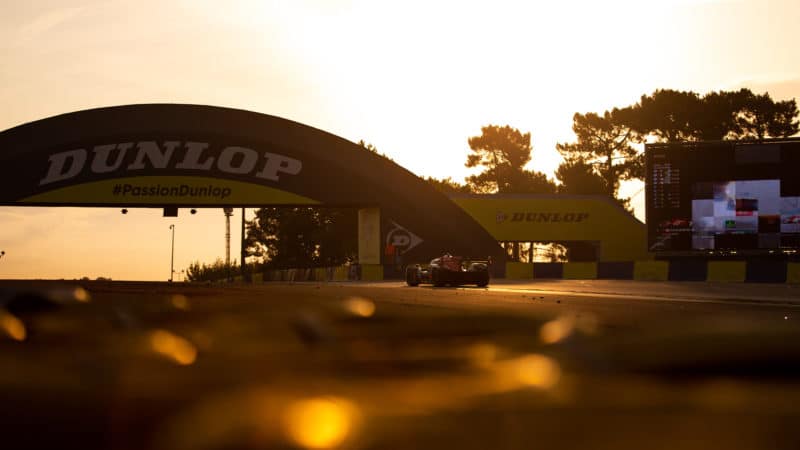
No7 Toyota emerged into the morning sun with a dominant lead
Joao Filipe / DPPI
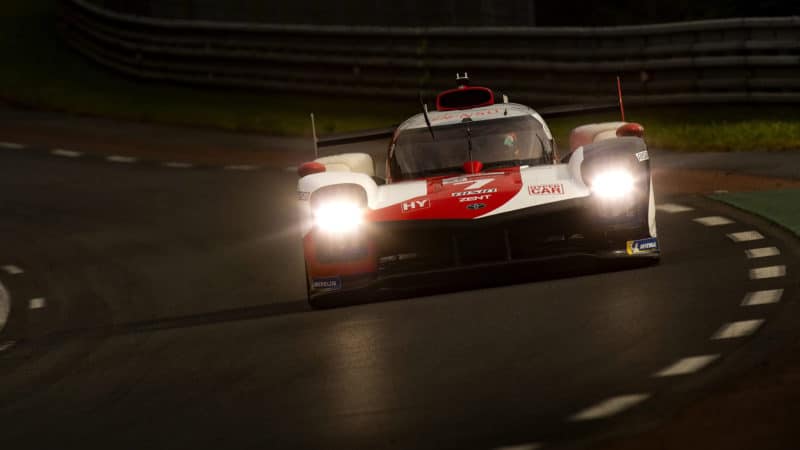
Toyota
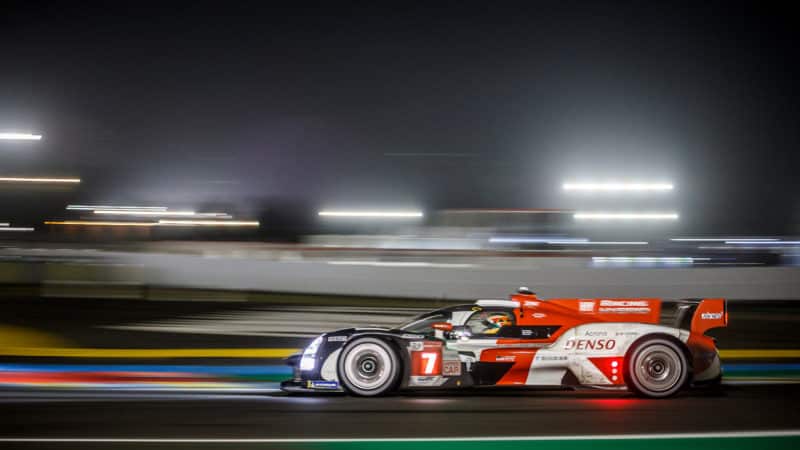
Frederich Le Floc’h/DPPI
As the sun rose (and with a brief blanket of mist) issues were starting to manifest for some of the leaders. Nakajima reported a vibration issue with the No8 Toyota, a portent of troubles to come. Meanwhile, Lapierre in the Alpine noted that the low temperatures made it tricky to get tyres up to temperature and bemoaned the fact that Happy Hour, the period after sunrise where cool temps and lightening skies normally see lap times tumble, was not an event for the French car.
Just before the 20 hour mark, disaster seemed imminent as Buemi in the No8 Toyota slowed to a halt out of Mulsanne, the driver reporting gear selection issues, however, another reset seemed to solve the problem. According to the team the car was also carrying a fuel system issue, and it would later confirm that the No7 was suffering a similar ailment, no doubt putting the Toyota pit on edge.
As the race transitioned into its final quarter, the status quo remained across much of the field, though there was an undertow of tension in the Hypercar class. It started to become apparent that Glickenhaus may have pulled off an excellent fuel strategy and, issues not withstanding, looked in with a chance to pip Alpine. The question was, would it be a battle for third place, or would Toyota’s issues manifest themselves more assertively, placing either rookie Glickenhaus or Alpine in line for a potential win.
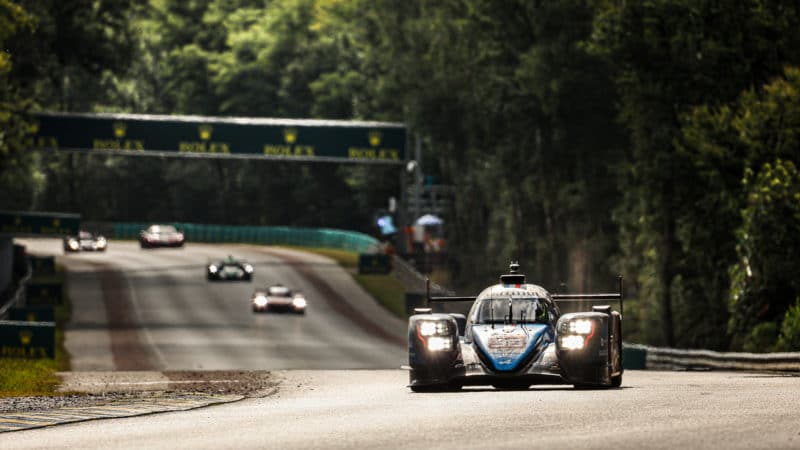
Alpine looked under threat from Glickenhaus fuel strategy
Francois Flamand/DPPI
In the end, the drama was not to be as Toyota was able to work around the issue, and unfortunately for Glickenhaus, an awkwardly timed slowzone scuppered its strategy and negated its pitstop advantage, leaving the 708 just over two minutes adrift of the Alpine as the last hour commenced. And so the order stayed until the finish, as did GTE Pro, with Corvette unable to gain on the pacey No51 Ferrari. The same was true in Am, with the No88 AF Corse leading in the No33 TF Sport Aston by a minute and a half.
Not the close battle many hoped for, but a testament to the quality of the fledgling Hypercar entrants. Talking to one senior WEC engineer on the Friday before the race, they suggested there was only a 50% chance a Hypercar would take the win, such was their lack of confidence in the cars’ reliability. The achievement was all the more impressive for Glickenhaus, an all-new team, with a new car built by a company that had never constructed a Le Mans machine, fitted with a similarly unproven engine. That both cars ran the 24 hours without a single hiccup was astounding.
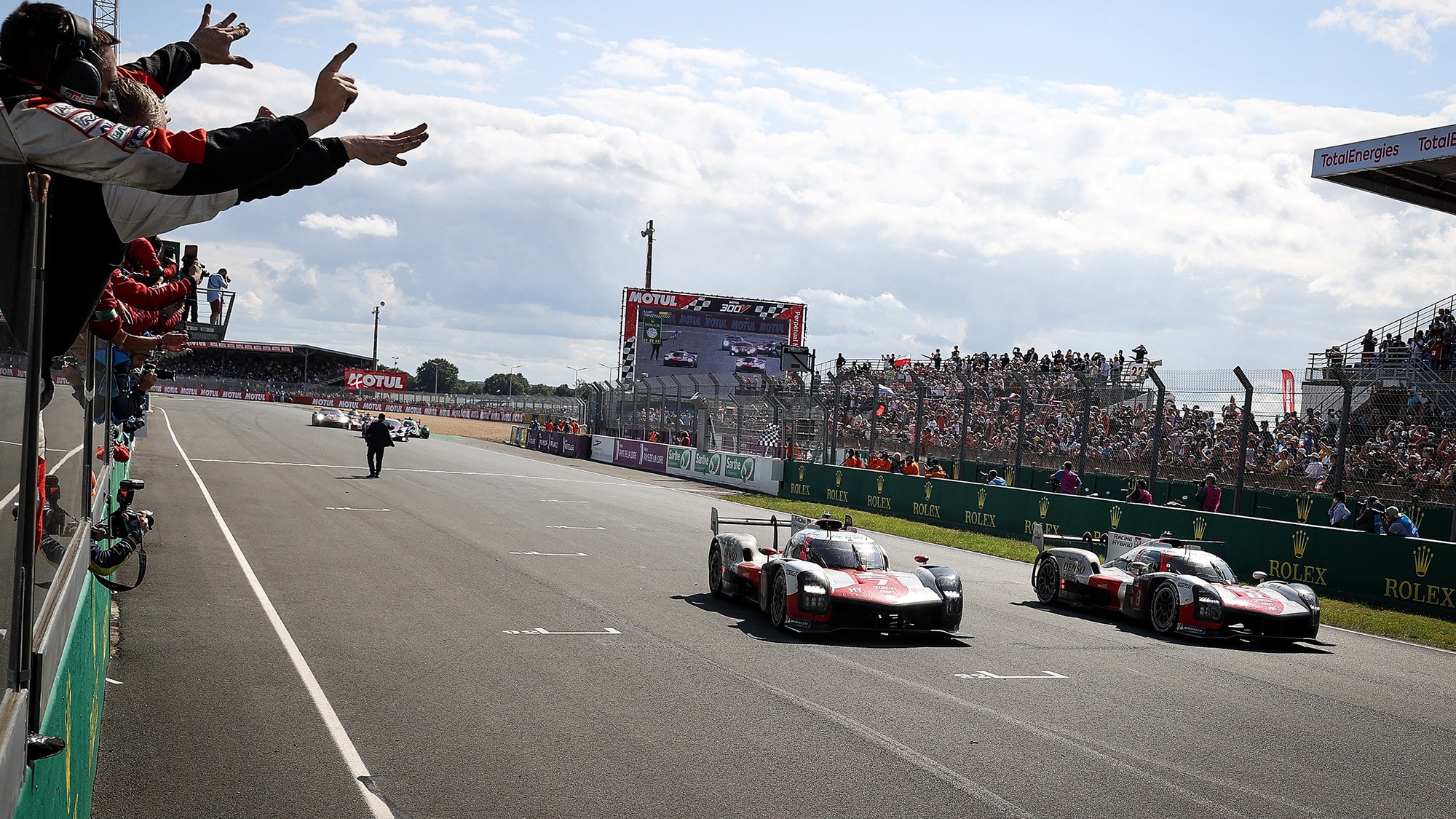
For the winning No7 Toyota crew, it was vindication after years bearing the brunt of Toyota’s bad luck. Looking at the reaction of British driver Mike Conway, the relief of finally securing a win was palpable. “We can enjoy now and celebrate,” he said after the race. “I feel like a weight has been lifted off, we’ve had some real bad luck here and it’s nice to get it properly done.”
Conway’s Argentinian teammate José María López hinted at the bond which had formed within the No7 team through its previous disappointments. “We came so far for so many years but, up to now, we couldn’t win Le Mans. All those experiences make the victory even more special. Mike and Kamui are like brothers to me and I have seen them doing things in the car which are just amazing. Of course there is a strong team behind us in Japan and Cologne. We take the glory but we couldn’t do this without this team.”
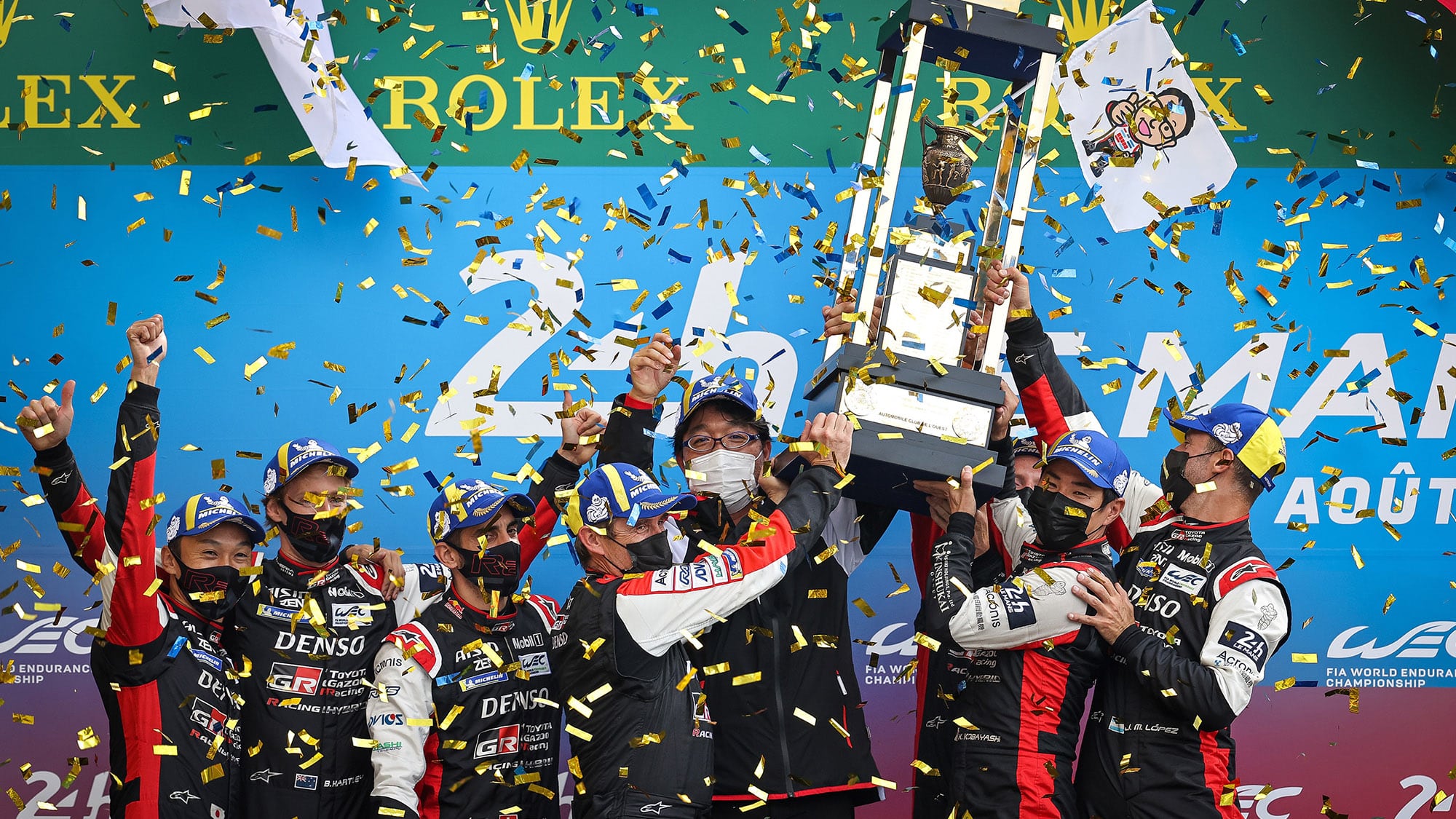
It was left to LMP2 to provide the last-minute drama. Tom Blomqvist in the No28 Jota was on a charge for second place in class, chasing down Robin Frijns in the No31 WRT. Then, in the way only Le Mans can, the hearts of the leading WRT crew were broken.
Looking set to cruise to the class win, Yifie Ye in the No41 ground to a halt on the run from Dunlop having just commenced his final lap. As with Nakajima’s Toyota disaster in 2016, the crew had the double blow of not even being classified as they failed to cross the line. Frijns saved the day for WRT, suggested as one of the front runners to operate Audi’s LMDh team, managing to fend off Blomqvist with barely two car lengths to spare by the finish.
So it was that another Le Mans came to a close, with a small foretaste of what is to come in the top category. 2022 will be another transitional year, with Peugeot joining the fray, but it is 2023 that holds real promise. The 100th anniversary of the race looks set to be a showdown between at least five manufacturers for overall honours, a tantalising prospect if ever there was one.
